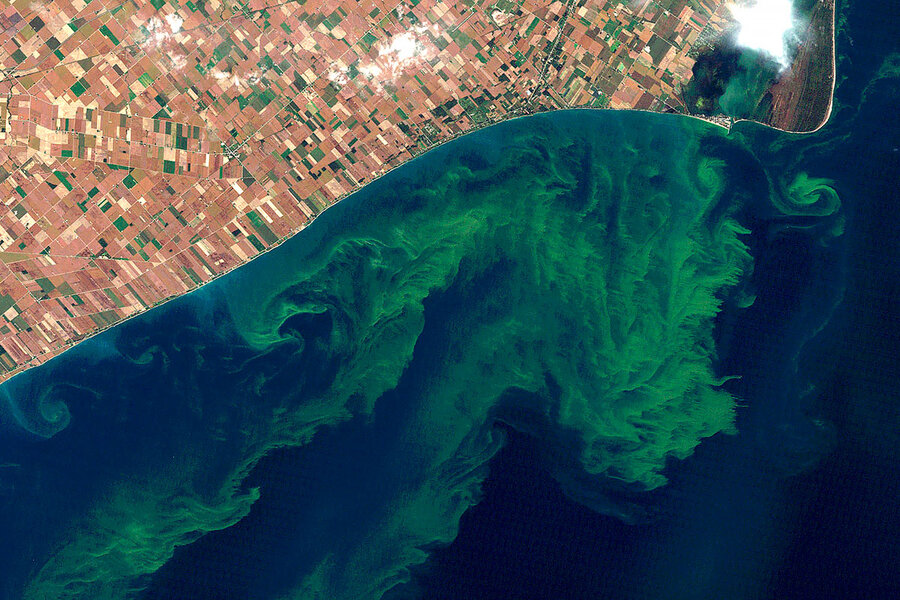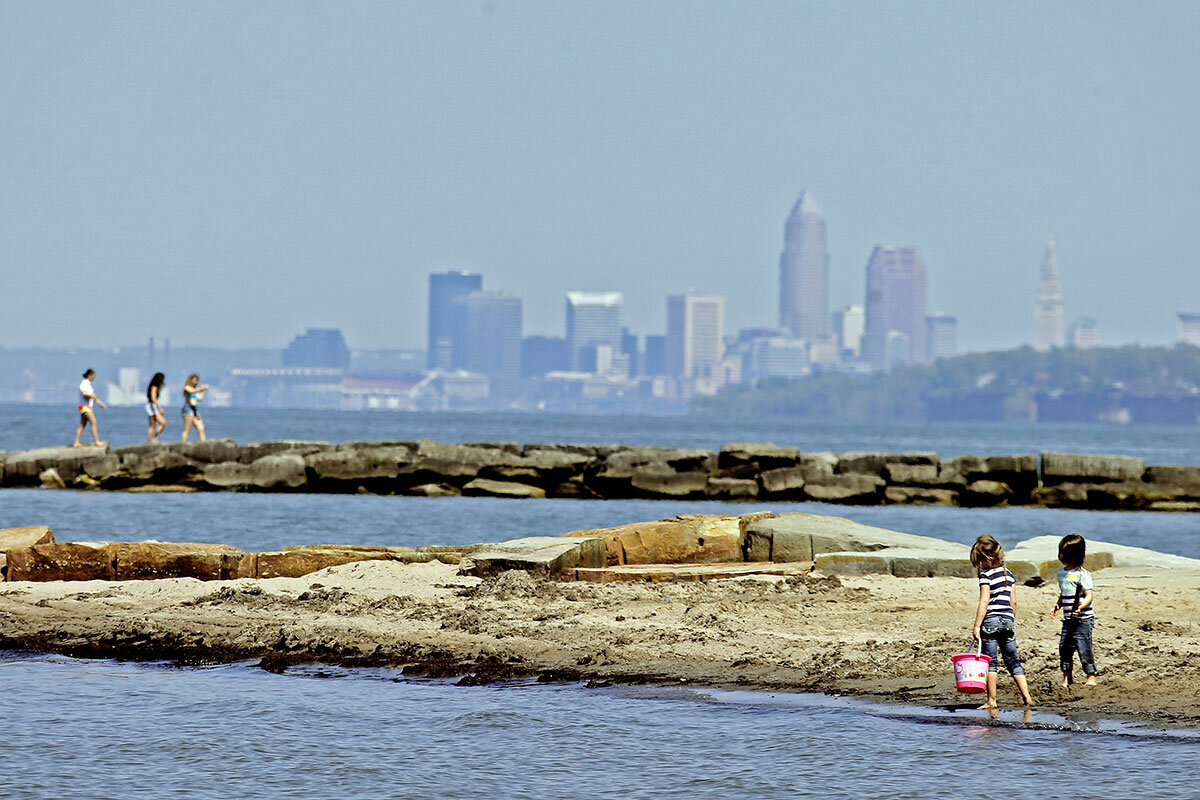Can a lake have rights? Toledo votes yes.
Loading...
Fed up with recurring, pollution-fueled toxic algae blooms, voters in Toledo, Ohio approved the “Lake Erie Bill of Rights.” Among other things, the bill guarantees the right of the lake and its surrounding watershed “to exist, flourish, and naturally evolve.”
The new law, passed last month, is the latest sign of a growing movement to recognize the rights of nature. Advocates are pushing a transformation in how the law views nature – from something that’s merely property, existing for the benefit of people, to an entity that has inviolable rights of its own. It’s a view that detractors say could cause legal chaos, and proponents see as a natural evolution of both the law and the moral consciousness of our society.
“We need to change how nature itself is treated under the law, much like we need to change how communities are treated under the law,” says Mari Margil, associate director of the Community Environmental Legal Defense Fund (CELDF), which advocates for rights for nature and helped draft the Toledo bill. “Our legal system – and the legal system mirrored around the world – needs a fundamental shift. It’s not going to be enough to regulate fracking or algae blooming better. It’s a really critical change that’s needed. We see this as aimed at that kind of transformational change.”
Why We Wrote This
Toledo, Ohio’s “Lake Erie Bill of Rights” is the latest example of a nascent global movement to grant legal standing to nature. But can this view of nature square with U.S. law?
It’s far from clear, however, whether Toledo’s law can hold up in court. The day after the Lake Erie Bill of Rights was approved by voters, a farmer filed a lawsuit questioning its constitutionality.
“It gives Toledoans, every Toledoan, jurisdiction over almost 5 million people, and 490,000 businesses, and every government entity and the 35 northern counties of Ohio. That is far beyond the city’s authority,” says Yvonne Lesicko, vice president of public policy for the Ohio Farm Bureau, which supports the farmer’s suit. Beyond the law’s unconstitutionality, she says, “it’s never good policy to regulate by litigation.”
Ms. Lesicko emphasizes that many farmers are already trying to adopt best practices to avoid runoff, and she believes lawsuits will only stymie those efforts and put farmers on the defensive.
Privately, even advocates of the law say they doubt it will survive a court challenge, but they view it as a long-term strategy that could be transformational over time. And, in various forms around the world, the concept that nature has rights is gaining momentum.
A fledgling movement
In the United States, several cities and towns have recognized rights for nature, particularly in Pennsylvania, where CELDF has actively advanced the concept. Pittsburgh adopted a nature rights provision in 2010 as part of a tactic to keep hydraulic fracturing out of the city. So far, though, no U.S. laws explicitly giving rights to nature have stood up in court in any sort of enforcement case, and most have been more general. Toledo’s is the first in the U.S. to grant rights to an ecosystem.
Internationally, the idea has gained more traction, with Ecuador enshrining the rights of nature in its constitution, and several countries – including Bolivia, Colombia, New Zealand, and India – recognizing rights of either specific ecosystems or nature more broadly (see sidebar).
In the U.S., however, critics maintain that rights of nature laws are inconsistent with our legal system.
“We’re a nation of laws and if we’re free to ignore those laws we have anarchy,” says Kent Holsinger, a Denver-based attorney who specializes in land and water law. “If you start inventing rights for trees and grass and rocks, that creates chaos, and it’s inconsistent with our system of government.” [Editor's note: An earlier version misstated Mr. Holsinger's first name.]
Before rights of nature can gain a foothold in U.S. jurisprudence a more significant question will likely have to be addressed: how to define “nature.”
“If you did create this right and you didn’t define it very narrowly you would have the [legal] floodgates opening,” says Jan Laitos, a professor at the University of Denver Sturm College of Law specializing in natural resources and environmental law.
Would it have to be a single living object, like a tree? Would it extend to a group of living objects, like a forest, or to inanimate objects, like a mountain? “What about a natural system like the climate? Could you bring a lawsuit on behalf of the planet’s climate which is being adversely affected by human beings? ‘The Earth’s climate vs. Con-Ed,’ or something?” asks Professor Laitos. “That could be one reason why we never want to create such a right. How do we limit it?”
Do inanimate objects have interests?
Whether or not such rights are actually inconsistent with the legal system depends on how they’re framed. American law recognizes nature primarily as a property interest, and in the courts, the rights of nature movement comes down to an issue of standing, or who has the right to bring a case before a court. A famous 1972 article in the Southern California Law Review that argued for rights for nature posed the question explicitly: “Should Trees Have Standing?”
“It is no answer to say that streams and forests cannot have standing because streams and forests cannot speak. Corporations cannot speak either; nor can states, estates, infants, incompetents, muncipalities (sic) or universities,” wrote University of Southern California professor of law Christopher Stone. “Lawyers speak for them, as they customarily do for the ordinary citizen with legal problems.”
The notion was tested in court in 1972, when the Sierra Club challenged an attempt by Disney to build a resort in Sequoia National Forest all the way to the U.S. Supreme Court. The justices rejected the suit, saying the Sierra Club had not shown there would be an injury. But in a famous dissent, Justice William O. Douglas made the case for why groups like the Sierra Club should be allowed to represent the interests of “inanimate objects” like trees in court.
“Those who have that intimate relation with the inanimate object about to be injured, polluted, or otherwise despoiled are its legitimate spokesmen,” he wrote. “Perhaps they will not win. Perhaps the bulldozers of ‘progress’ will plow under all the aesthetic wonders of this beautiful land. That is not the present question. The sole question is, who has standing to be heard?”
For decades Justice Douglas’ dissent garnered little interest, and the high court has made it more difficult to meet standing requirements in environmental protection cases. (This term, the justices ruled unanimously in favor of private landowners seeking to limit the protected habitat for an endangered species of frog.)
But the dissent has reemerged in recent years, and in a 2015 ruling in Pennsylvania, a judge sidestepped the question of whether a creek had standing, leading some experts to think that there could be an acceptable way for the rights of nature to be presented in American courts.
“When that decision in Pennsylvania came out ... people began to think, ‘Uh huh, this is something that might be workable, so long as we make it reasonable,” says Hope Babcock, a professor at Georgetown Law.
Translating stewardship into law
One option would be to establish a limited guardianship, where “nature” is represented by judicially vetted and approved groups. For people who lack an ability to represent themselves, Professor Babcock adds, guardians are “a time-honored concept in American law.”
Mary Wood, a professor at the University of Oregon School of Law, argues that there’s another way for nature’s rights to mesh with U.S. law, using the public trust doctrine: the concept that the government holds some resources in trust for the public. It’s a concept that goes back to ancient Rome, and that has been held up in numerous instances in U.S. courts. And, while Professor Wood notes that some rights of nature advocates aren’t comfortable with it because it’s grounded in property law, she says the doctrine ultimately declares that some resources are so crucial to society that they can’t be privatized.
“Rights of nature needs the public trust standards to be viable in court,” says Professor Wood. “The rights of nature cannot be just an appeal to an awakened human sensibility. To have traction, it has to be enforceable in court, and it has to be recognizable in court.”
It remains to be seen how Toledo’s lawsuit will play out – and it seems unlikely that the current courts in the U.S. are ready to recognize the lake’s rights in the way they’re written. But for advocates, it’s a chance to illustrate the failures of the current regulatory system and, they hope, to move the concept forward.
“We can’t rely on the EPA to do anything at this point,” says Crystal Jankowski, a Toledo mother and graphic designer who helped push for the bill of rights with Toledoans for Safe Water, a grassroots organization. Ms. Jankowski was in the hospital giving birth to her daughter in 2014 when one of the water crises hit the town, and hundreds of thousands of residents were told not to drink their water for two days.
Voters approved the law, she notes, despite a barrage of attack ads opposing the measure, because residents were so fed up. And in the weeks since the law was passed, she’s had communities across the country reach out wondering how they could pass similar legislation. “This is not an isolated incident,” says Ms. Jankowski. “This is a growing movement.”
Professor Wood concurs that our relationship with the natural world is undergoing a shift. The rights of nature movement, she says, “represents a moral awakening that is truly global, a recognition that human destruction of nature is having horrific consequences not only to the human species but to all of nature. The human conscience suddenly feels responsible.”






